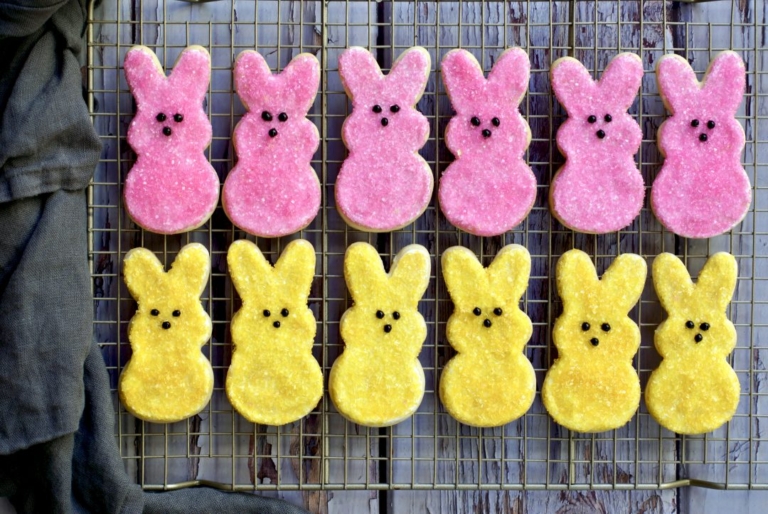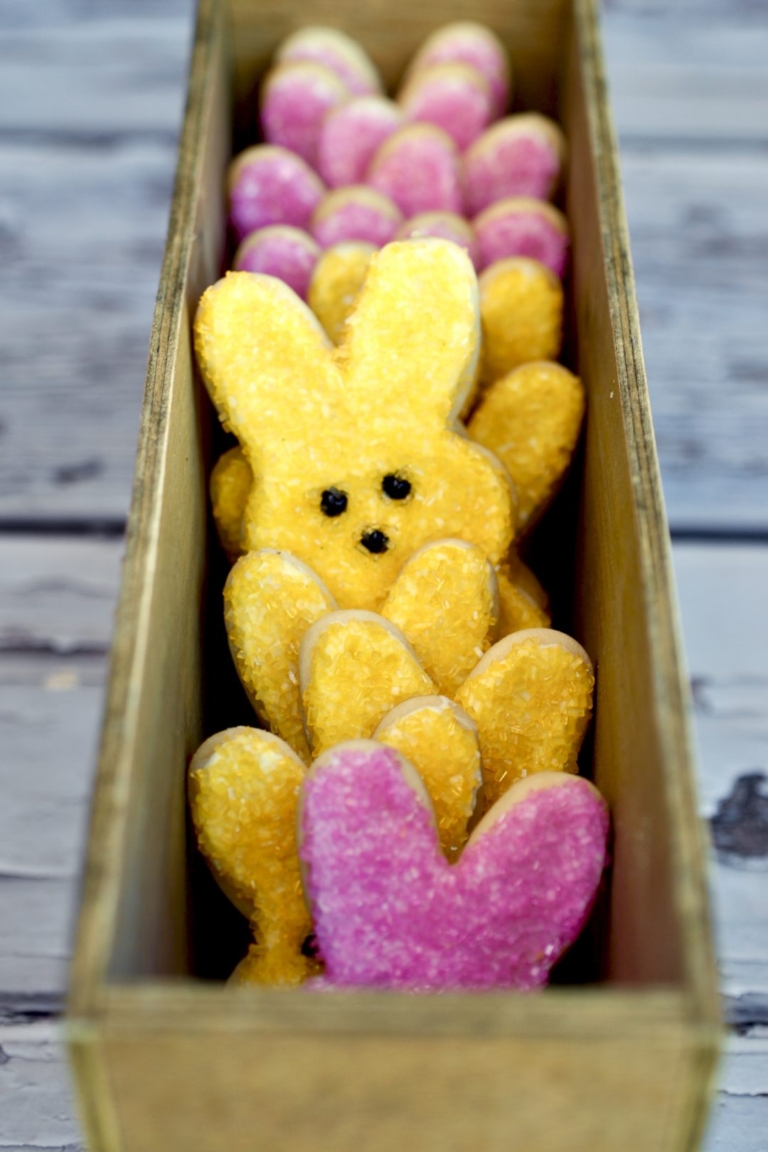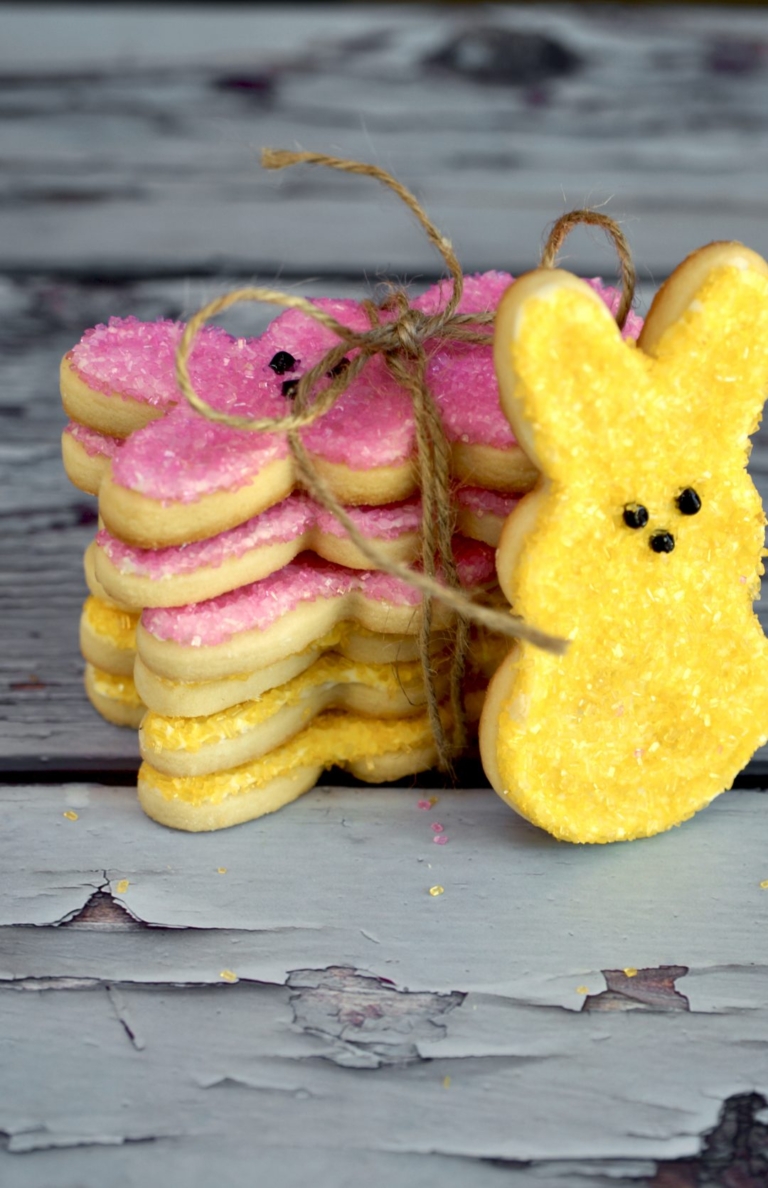Shortbread Peep Cookies

Calling it like it is, Easter is not going to be the same this year. Thankfully we have Zoom and a way for families to “be together” even while apart. During these trying times of social distancing, everyone needs to get creative. These shortbread peep cookies are my creative way to celebrate Easter, since I’m willing to bet Easter candy is not as easily obtainable through Instacart deliveries.
Peeps are an iconic childhood treat I loved and hated as a kid. Although my family was not very religious growing up, we were still Christians, and for my sister and me that simply meant presents under the Christmas tree and a bountiful candy basket on Easter morning.
Peeps were always in our Easter basket, something I expected, yet did not want to eat. There were not many others like me. Most kids I knew loved Peeps and gladly gobbled them up without thinking twice. I guess you could say I was more of a peep enthusiast, I loved the idea of cute, brightly colored sugarcoated marshmallows, I just didn’t love the taste of them. But before I can talk about these shortbread peep cookies, I need to provide some history.
The Story of Peeps
In 1953, Peep candies were purchased from the Rodda Candy Company by Sam Born, a Russian immigrant who first made a name for himself in 1916, when he developed the first machine that could mechanically insert sticks into lollipops. Born was considered a confectionary genius and it was he who turned those brightly colored, sugary marshmallow chicks into a must-have Easter basket phenomenon that continues to this day.
By 1954, Peeps had become so popular that Just Born Inc. had to develop a way to automate the process and quickly cool the Peeps. The candy company also developed special high-volume machines to keep up with the production demand. This machine revolutionized the Peep-making process and shortened the manufacturing time to about 6 minutes. The speed of the assembly line helped Just Born Inc. to become the biggest marshmallow candy company in the world.
In 1958, the company introduced the first pumpkin-shaped marshmallow treats for Halloween, followed by Christmas snowmen and trees, and now of course, the myriad of other shapes and varieties including modern-day emojis.
Fun Facts About Marshmallow Peeps
- Peeps were originally formed by hand in a process that could take over 24 hours per individual Peep.
- The original Peep had two small wings coming off the back of each bird.
- Today over 5 million Peeps candies are made per day.
- The original Peeps were yellow. Laker pink and white birds had joined the mix. In 1995, blue and lavender birds were introduced. By the turn of the century, vanilla, chocolate, and strawberry flavors were added.
- Traditional marshmallow Peeps remain one of the most popular Easter candies, but for the holiday itself, bunny-shaped Peeps overtake the standard birds.
- Each classic, chick-shaped candy contains 28 calories per bird (that’s 140 calories for a pack of five).
- Roughly one-third of all Peeps purchased are not eaten but used for decorations or dioramas instead.
- Despite Peeps’ status as the iconic Easter candy, Sam Born and his descendants are actually Jewish – so they don’t celebrate Easter.
My love of cookies is no secret, and with all my stress baking, this post should be no real surprise. These shortbread peep cookies are my nod to the classic peep candies I anticipated in my Easter basket each year. But these bunny peeps are more my style. A soft buttery shortbread cookie base, cut extra thick how I like it, and covered in traditional yellow and pink Peep colors for nostalgic purposes.
Shortbread Peep Cookies
Ingredients:
For the Shortbread:
- 1 cup unsalted butter, softened
- 1/2 cup confectioners' sugar
- 1 teaspoon vanilla extract
- 2 cups all-purpose flour
- 1/4 teaspoon salt
For the Glaze + Topping:
- 2 cups confectioners' sugar
- 1 teaspoon vanilla extract
- 4-5 tablespoons milk
- Pink and yellow crystal sprinkles
- Black decorating gel
Directions:
- For the Cookies: Preheat oven to 350 degrees F. Line two baking sheets with parchment paper and set aside.
- In a kitchen mixer, such as a KitchenAid, fitted with a paddle attachment, add the butter and beat until soft and fluffy. Add the confectioners' sugar and vanilla, and beat until smooth. With the mixer on low, slowly add the flour and salt, and mix until incorporated.
- Form the dough onto a disk, wrap it in plastic wrap, and refrigerate for at least 15 minutes.
- Remove the dough from the refrigerator and roll the dough out on a lightly floured work surface till it's about 1/4-inch in thickness.
- Use a 4" bunny peep cookie cutter (or by making a stencil and using a paring knife) to make the cut-out cookies. Place on the prepared baking sheets and place in the refrigerator for about 15 minutes. Remove from the refrigerator and place in the oven. Bake the cookies, rotating halfway through for about 12-15 minutes, or until firm but without coloration.
- Remove the cookies from the oven and allow them to cool completely before decorating.
- For the Glaze + Topping: In a small mixing bowl whisk the confectioners' sugar, vanilla, and 3 tablespoons of the milk. Mix well. Add more milk, one teaspoon at a time, until a thick but drizzle-able glaze is formed. Set aside.
- Pour the sprinkles into two small shallow-rimed bowls and place them near your workstation. Dip one cookie at a time into the glaze. Let the cookie sit on the top of the glaze and gently push down to ensure the surface of the cookie is covered. Gently pull the cookie out of the glaze and allow the excess icing to drip off. Flip the cookie right side up and give it a gentle jiggle to allow the glaze to flow evenly over the surface.
- Next, dip the glazed shortbread into either the pink or yellow sprinkles. Place on a wire rack to dry. Repeat the above process with the remaining cookies.
- After all the cookies have been dipped in sprinkles use the black decorating gel to make two eyes and a nose on each cookie. Allow the cookies to sit for a least one hour to set the icing before placing them in a container.








